MI504: Miscon Four:
The idea that Dark Matter is different from ordinary matter is a Giant Misconception
David Noel
<davidn@aoi.com.au>
Ben Franklin Centre for Theoretical Research
PO Box 27, Subiaco, WA 6008, Australia.
What is Dark Matter?
The term "Dark Matter" was invented by the brilliant Swiss-American astronomer Fritz Zwicky in the 1930s to represent a source of gravitational attraction in distant galaxies.
Zwicky noted the rotation rates of some of these galaxies, and showed that the distribution and masses of all the stars known in a given galaxy was markedly insufficient to explain its rotational behaviour -- the galaxy had to contain a lot of some substance in a form which could not be seen in ordinary telescopes, but which had the gravitational properties of matter. Zwicky coined the label "Dark Matter" for this unknown substance.
Here is an extract from what a conventional source, Wikipedia, has to say about Dark Matter [1].
"Dark matter is a form of matter thought to account for approximately 85% of the matter in the universe and about a quarter of its total energy density.
The majority of dark matter is thought to be non-baryonic in nature, possibly being composed of some as-yet undiscovered subatomic particles. Its presence is implied in a variety of astrophysical observations, including gravitational effects which cannot be explained by accepted theories of gravity unless more matter is present than can be seen.
For this reason, most experts think dark matter to be abundant in the universe and to have had a strong influence on its structure and evolution. Dark matter is called dark because it does not appear to interact with observable electromagnetic radiation, such as light, and is thus invisible to the entire electromagnetic spectrum, making it extremely difficult to detect using existing astronomical instruments.
Primary evidence for dark matter comes from calculations showing many galaxies would fly apart instead of rotating, or would not have formed or move as they do, if they did not contain a large amount of unseen matter.
Because dark matter has not yet been observed directly, if it exists, it must barely interact with ordinary baryonic matter and radiation, except through gravity. The primary candidate for dark matter is some new kind of elementary particle that has not yet been discovered, in particular, weakly-interacting massive particles (WIMPs).
Many experiments to directly detect and study dark matter particles are being actively undertaken, but none have yet succeeded."
There is an unfortunate thing about scientific theories -- once an accepted idea goes "off-track", but undergoes further development, researchers devise more and more elaborate stories and gimmicky explanations in the face of new objections to the theory. The pile of bullshit (aka hogwash, bunkum) so created becomes so high, that few later observers are bold enough to challenge convention, and point out that the pile is obscuring the proper view.
And so with theories about Dark Matter. A simple and (in hindsight) obvious explanation is readily available, one not involving "WIMPs" or any form of "non-baryonic material".
Dark Matter is just ordinary matter in space outside solar systems
Surrounding our Solar System there is a mess of bodies smaller than stars, known as the "Oort Cloud".
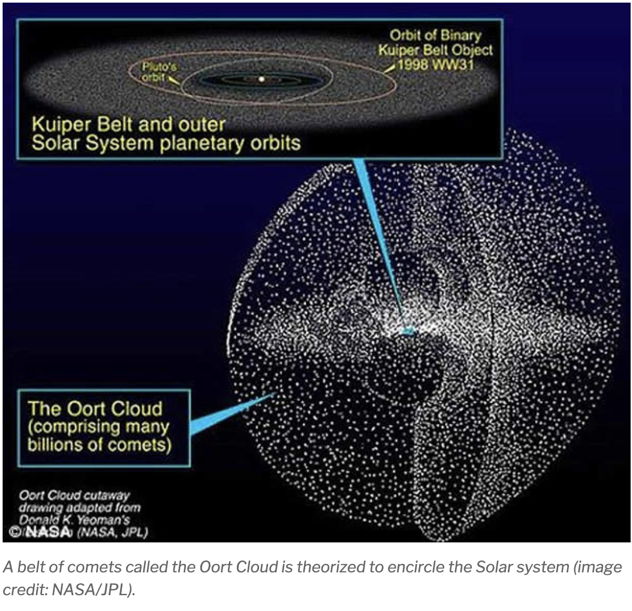
Figure MI504-F1. The Oort Cloud. From NASA.
The existence of such an entity has been known for a long time, but only recently has a fairly detailed picture started to emerge. The Oort Cloud is the source of "long-period comets" -- comets which swing into the Solar System on apparently highly-elliptical orbits. Unlike shorter-period comets (like Halley's Comet, which return regularly), the long-period comets appear once, circle the Sun, and shoot off into interstellar space, never to be seen again.
Until relatively recent times, these comets were almost the only way of gaining information about the Oort Cloud. Comets have quite low masses, so if the Oort Cloud only contained comets, its total mass might be guessed to be tiny compared to the mass of our Sun. Now a far more detailed understanding of the Oort Cloud is emerging, dependent on two quite different modes of investigation.
Planetary bodies beyond the Solar System
Our Solar System has has an outer boundary called the Heliosphere, like a giant bubble. It is a real boundary, rather than an arbitrary one, for at least two reasons.
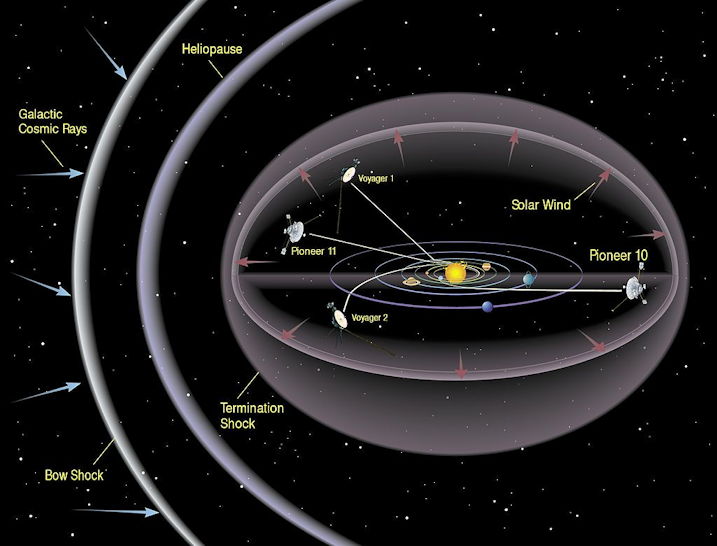
Figure MI504-F2. The Heliosphere. From NASA.
First, within the Heliosphere, all the planets, asteroids, and comets are under the overwhelming gravitational control of the Sun. Beyond its edge, the Heliopause, the Sun is only one of the gravitational regimes acting on Oort Cloud bodies -- with inner Oort Cloud objects, the Sun's influence is still strong, but further out into the Cloud, objects will no longer be "orbiting" the Sun, their movements will be more and more independent.
Second, some local conditions have been shown to alter on passing through the Heliopause. The space probe Voyager 1 crossed the Heliopause in 2012, and its instruments revealed that it had crossed a boundary in the direction of the local magnetic field. There is more on this in P4: The Greater Averaged Universe (GAU) [7].
The size of the Solar System
Some figures may help to give a better picture of the sizes involved here. The Heliosphere has a radius of about 100 AU, where 1 AU (Astronomical Unit) is the distance from the Earth to the Sun.
The 8 planets (now that Pluto has been demoted to a dwarf planet) consist of the 4 inner rocky planets, with Mercury and Venus closest to the Sun, then Earth and Mars. The 4 outer "gas giants" are Jupiter, Saturn, Uranus, and finally Neptune, about 30 AU out from the Sun.
Between Neptune and the boundary of the Heliosphere is a region called the Kuiper Belt, which contains a number of dwarf planets and asteroids. The true planets orbit fairly close to the Sun's equatorial plane (the "ecliptic"), but Kuiper Belt objects (which include some short-period or repeating comets) have orbits inclined to this plane, and the inclinations tend to be greater, the further from the Sun.
With improving telescopes and observational techniques, more and more smaller objects ("dwarf planets") are being recognized as existing within the nearer Oort Cloud, many of which never penetrate into actual Solar System space. Figure F3 following shows the orbits of about 13 of these TNOs ("Trans-Neptunian Objects" -- the 4-digit number in a label denotes the year of discovery).
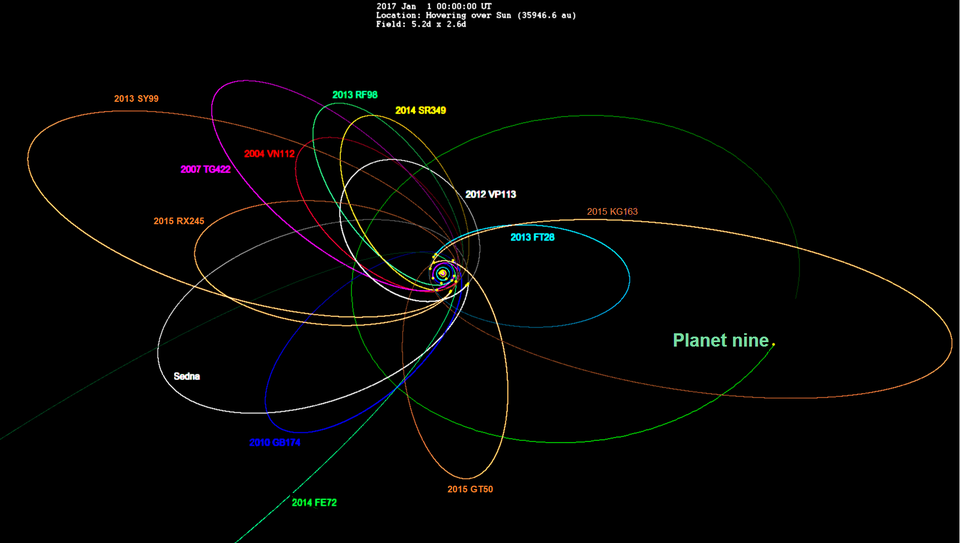
Figure MI504-F3. Trans-Neptunian Objects. From [4].
In the figure, the tiny blue circle at the centre is the orbit of Neptune, so many of the orbits take these TNOs far, far out into the Oort Cloud proper. Even so, these TNOs have only been found because on part of their orbit, they come close enough to the Heliosphere to be accessible to modern instruments. They also need to be above a certain size, to reflect enough light to be detectable. As of 2019, more than 2600 of these TNOs have been identified [8].
So a true OBO (Oort Cloud Object), following a path which never takes it closer than, say, 150 AU from the Sun, is most unlikely to be found with current techniques. Even a relatively large object like Sedna, with a diameter of almost 1000 km, would not have been detected if its orbit around the Sun was more circular.
Looking for Planet Nine -- and beyond
Looking again at Figure F3, it can be seen that that most of the orbits shown are not randomly placed, but are preferentially over to the left. Researchers analyzing these orbits have come to the conclusion that the pattern shown is due to the presence of another large planet, as yet identified, which is being called Planet Nine.
Planet Nine is thought to be 10 times the mass of the Earth, almost as large as the outer gas giants Uranus and Neptune. It will be difficult to locate with optical telescopes, if it exists, just because it is so distant -- it would be less than one-thousandth as bright as it would if it was at the distance of Pluto.
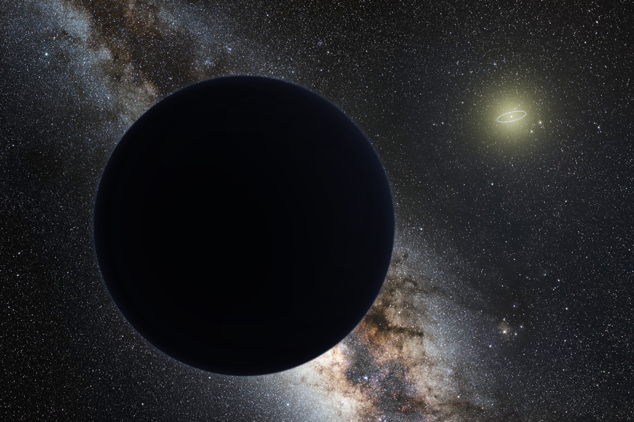
Figure MI504-F4. The view from Planet Nine. From [4].
Figure F4 gives an artist's impression of what it would look like from behind Planet Nine, looking towards the Milky Way. The little bright ellipse on the top right represents the entire Solar System. There is more on Planet Nine at XT811 - Planet Nine, Doorkeeper to the Oort Worlds. [4].
The Oort Cloud has no outer boundary, it is really just our part of all the matter in interstellar space, "OortSoup". But if we imagined it as sphere extending almost halfway to the nearest star, about 4 light-years away, it would have a radius of 100,000 AU, so the Solar System would have only one-billionth of the volume of the Oort Cloud.
Viewing the position from the inside out, it is clear that our Oort Cloud has plenty of space to contain a profusion of bodies right up sub-star size, possibly whole sub-solar systems, with their own planets orbiting big central bodies not quite massive enough to achieve ignition and shine by their own light.
Looking from the outside in
There is another approach to identifying what the Oort Cloud might contain, by looking at known data about the masses and frequency of occurrence of stars.
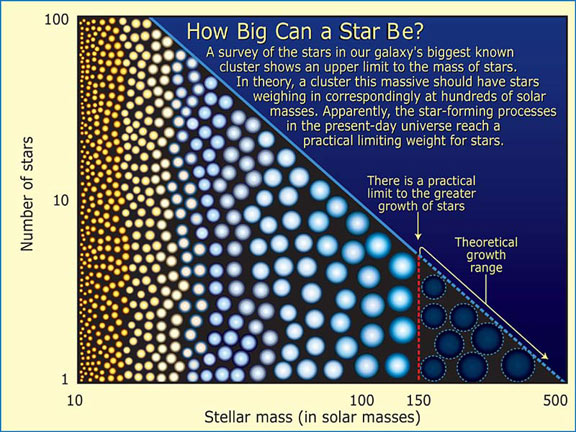
Figure MI504-F5. Star sizes and distribution. From [3].
Figure F5 gives a representation of this topic. The very largest stars known, called blue giants, have masses up to about 150 times that of the Sun. There are relatively few of these.
Looking at stars with lower masses, these become more numerous, the lower their mass. The smallest stars, called red dwarfs, are very numerous, making up 70% of all the stars in the Galaxy [3]. Objects smaller than red dwarfs do not have enough mass to sustain the fusion reactions which power stars, and so cannot be detected by the light they give out.
How many objects smaller than red dwarfs would we expect to encounter, in a given area of the Universe? Older ideas on how planet formation have often assumed that they formed at the same time as a "parent" star, but newer work suggests that bodies form by aggregation of matter throughout space, and it is only when one of these aggregation reaches star mass that we can detect it.
In other words, the view is that planetary aggregation happens first, and that stars are the children of continued aggregation of planetary material -- when the mass of an aggregation is big enough, "ignition" occurs, and the new star can be detected by the light it gives off. Meanwhile, all the aggregations which are not star size ("Oort Soup") continue in space, with chaotic movement according to their past history.
With the normal trend to have greater number of objects of smaller categories, as with red dwarfs, we would expect interstellar space to be full of objects smaller than stars, which together would exactly fill the role of Dark Matter -- unseen in the visible spectrum, but exerting normal gravitational effects according to their mass. There is more on the formation of stars and solar systems in interstellar space in P1: The Cosmic Smog model for solar system formation, and the nature of 'Dark Matter' [5].
Dark Matter and CMBR
In a related article, MI503: Miscon Three: The idea that CMBR came from the Big Bang is a Giant Misconception [9], evidence is presented that the Oort Soup is the same thing as Dark Matter, and is the source of the CMBR (Cosmic Microwave Background Radiation) which permeates the Universe.
This means that CMBR data can be used to analyze the nature of Dark Matter in our vicinity. For us on Earth, most of the CMBR comes from the closer regions of our Oort Cloud. Most of it is from cold bodies existing at less than about 3 K, three degrees above Absolute Zero. This is a rich field of enquiry which has hitherto been almost completely neglected.
However there must also be larger objects, the Oort Worlds, which are warmer than 3 K because they generate their own internal heat. In our Solar System, the more massive the planet, the warmer is its active core. Jupiter, our largest planet, actually generates slightly more heat internally than it receives from the Sun.
The article on Planet Nine [4] points out the possibility of "Subsolar Systems", systems of planets and other objects orbiting a massive central object, not quite large enough to become a star. These are sometimes called Brown Dwarfs, substellar objects that occupy the mass range between the heaviest gas giant planets and the lightest stars, of approximately 13 to 75 Jupiter masses.
Brown Dwarfs are only one step smaller than Red Dwarfs. They do not emit light in the visible spectrum, but do shine in the next wavelength down, the infrared. It is in the extensive infrared bands, between the visible and the microwave bands, that the opportunity to greatly enlarge our knowledge of the Oort Soup lies.
* * * * * * * * * * * * * * * * * *

References and Links
[1]. Dark matter. https://en.wikipedia.org/wiki/Dark_matter .
[2]. Martin Ratcliffe. State of the Universe 2007. Springer, 2007.
[3]. Charles Q Choi. Red Dwarf Stars might be the best places to discover alien life. https://www.astrobio.net/alien-life/red-dwarf-stars-might-best-places-discover-alien-life/ .
[4]. David Noel. XT811 - Planet Nine, Doorkeeper to the Oort Worlds. http://aoi.com.au/Extracts/XT811.htm .
[5]. David Noel. P1: The Cosmic Smog model for solar system formation, and the nature of 'Dark Matter'. http://www.aoi.com.au/bcw1/Cosmic/index.htm .
[6]. David Noel. P3: Living In The Universe: (What CMBR tells us about Dark Matter, and much more). http://aoi.com.au/Living/ .
[7]. David Noel. P4: The Greater Averaged Universe (GAU). http://aoi.com.au/GAU/index.htm .
[8]. List of trans-Neptunian objects. https://en.wikipedia.org/wiki/List_of_trans-Neptunian_objects .
[9]. David Noel. MI503: Miscon Three: The idea that CMBR came from the Big Bang is a Giant Misconception http://www.aoi.com.au/acceptology/MI503/index.htm .
Go to the Acceptology Home Page

Version 1.0 compilation started 2019 Aug 13, first version on Web 2019 Aug 18.








